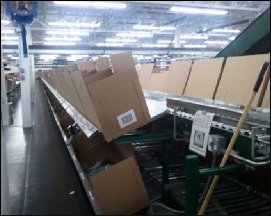How a Put System in Your Distribution and Fulfillment Operations Can Overcome Key Challenges
Introduction
As competition rises among retailers, it is no surprise that organizations across all verticals are looking to cut warehousing costs now more than ever. Some of the most obvious ways for organizations to cut these costs is to decrease labor, increase productivity, and to optimize square footage usage-all while maintaining a high level of order accuracy.
Often times, improvements in these areas are easier said than done. Choosing the right technology to propel the organization forward is key. With the complexities of today’s warehouses, the presence of multichannel, and seemingly endless new technologies, it is hard to decipher the best solution for any particular situation. While put systems are not the best answer for every operation, they can often provide a critical benefit to order fulfillment processes.
The State of Today’s Logistics
Today’s consumers crave a flawless experience. As a result, traditional retail and wholesale distribution centers (DCs) and fulfillment centers (FCs) need to evolve into flexible and personalized DCs, FCs, and/or combination of the two. Similarly, customers want to personalize delivery by either buying the product online or instore. Product is picked up at a store or locker, or is delivered to homes/other location.
Designing a multichannel facility for today’s environment requires significant elasticity in the operation.
Multichannel logistics has a long road ahead and many challenges to overcome. Warehouse facilities are traditionally designed to efficiently serve only one channel at a planned level of volume. This process lacks the flexibility to expand and accommodate swings in requirements. They are either effective in their ability to ship cases to wholesale and retail customers, or they are effective in fulfilling smaller, mixed case shipments directly to consumers.
Flexibility is the key when designing for multichannel logistics. Order and shipment size are vastly different, seasonality is more volatile, cycle times are shorter, return rates are higher, and personalized valueadded services are crucial.
Expanding a facility’s capability to meet distribution and fulfillment requirements of personalized logistics across all channels is certainly not easy, but when done successfully, it can bring huge advantages.
What are the Picking Methodologies?
For any DC or FC, choosing the best picking methodology sets the stage for the most efficient operation. Every picking methodology has its pros and cons, and each is best suited for different scenarios:
-
Discrete Order Picking is the most basic way of picking an order. The orderpicker picks one order, one line at a time. This is ideal for paperbased picking and provides a fast response time for order fulfillment. This methodology is the most inefficient because it requires a significant amount of travel time.
-
Zone Picking assigns orderpickers a specific zone to pick items from and pick all the stockkeeping units (SKUs) in that zone for an order. If an order has SKUs located in multiple zones, then the order is filled by passing it through each zone or the picks from every zone are brought to a forward order consolidation area.
-
Batch Picking occurs when pickers pick all of the SKU requirements for multiple orders at once. This method allows for much less walk time as they only need to travel through the pick path once for each batch. However, the picker must be able to transport multiple orders simultaneously and sort the items to the order level during or after the picks.
-
Zone Batch Picking is a combination of the above methods and occurs when multiple pickers pick all the SKU requirements for multiple orders at once, but they are limited to their defined zone. This decreases the cycle time required for batch picking, while also reducing the amount of product the picker needs to be able to manage. Orders will still need to be sorted and consolidated prior to shipping.
|
Order Picking Methodology |
Pickers Needed Per Order |
Line Items Per Pick |
Zone Types |
When to Use |
|
Discrete Picking |
Single |
Single |
Warehouse |
|
|
Batch Picking |
Single |
Multiple |
Warehouse |
|
|
Zone Picking |
Multiple |
Single |
Fixed Length |
|
|
BatchZone |
Multiple |
Multiple |
Fixed Length |
When the operation has similar characteristics for the above batch and zone picking |
Figure 1. Order Picking Methodology
Since order fulfillment first became more automated for catalog sales back in the 1980s, its main justification has been to remove the travel time and distance by staff involved in processing orders. Although much has changed since then with both customer expectations and technology, the objective and challenges are in many ways still similar.
Eliminating walk and travel time has been met with limited success in the past. But with the recent evolution of multichannel fulfillment, order fulfillment operations must be more flexible to meet the wide variability in order profiles, SKU count, and customer service requirements. Batch zone picking is the only way to effectively reduce the travel time.
|
Challenges Multichannel Facilities Must Meet |
|||
|
Characteristics |
Wholesale |
Retail |
DirecttoConsumer |
|
Units per Order |
Highest |
Medium |
Lowest |
|
Lines per Order |
Highest |
Medium |
Lowest |
|
Order to Fulfillment Cycle Time |
One or More Weeks |
Days to Weeks |
Hours to Days |
|
ValueAdded Services |
Low to Medium |
Medium |
Potential for Highest |
|
Returns |
Lowest |
Vary, But More Controllable |
Highest |
Figure 2. Multichannel Facility Challenges
The Batch Zone Is Picked-Now What?
Within a DC, walking from one location to the next can account for up to 60% of a picker’s time. Depending on the order profile and the average cubic size of the order(s), batch picking can increase pick rates up to 3 or 4 times traditional discrete order picking. Batch picking allows for decreased walking for pickers because a picker only has to go to a location one time within a batch of orders.
That is the good news. The downside of this picking process is that the items must be sorted out and consolidated to the order level. To perform this, the traditional methodology for a highvolume DC is through the use of unit sortation.
There are several different sortation technologies, each with their own benefits to properly fill their role in any DC. The list includes tilt tray, bombbay, and crossbelt sorters. To determine which sortation technology to use, one must consider the type, diversity, and predictability of the items in the warehouse.
Unit sortation technology has traditionally been used to keep up with extremely high volume items by automatically separating batch picked items and grouping them for packaging to their final destinations. This process can handle diverse product types and sizes with very high accuracy, but can be problematic when products are delicate, have inconsistent packaging, or the weight and size vary dramatically.
In addition, unit sortation has a high cost of entry and can often only be justified when it can be fully leveraged for several hours a day, most days of the year. In many operations, the volumes are not consistent to justify the expense, the product varies too greatly to be able to reliably sort, or other factors require alternative order consolidation systems such as “puttolight” operations.
Put System Overview
Put systems are not a new technology. Traditional uses include the old postal bin walls used to manually sort mail down to cities, zips, routes, or even customers. This conventional system evolved into “put walls” for order picking of larger items, but remained manual for some time. In retail fulfillment operations, it was commonly referred to as a puttostore system.

With the advent of picktolight systems, this technology was soon “reversed” to provide a directed method of manual sortation of goods. This system, later known as puttolight, was a big improvement compared to paperbased or RFdriven processes.
The premise is to speed the sortation process while improving overall accuracy through the positive direction of tasks. Light direction allows operators to better free their hands for the transfer of product and removes the need to read and act on instructions via a screen or paper.
Regardless of the technology, put systems are built on the same concept. Batch picked product is delivered to an operator, who will then sort out the product to multiple orders.
When the operator completely sorts the batch picked product, he can then continue to sort product from another zone into the same set of orders. The operator can either sort the product directly into the shipping container, or an intermediate container can be used. As orders or containers are filled, they are then moved to a packout area and later to shipping.
Put System Applications
Unit sortation is certainly an appropriate and top application in many instances. Both unit sortation and put systems work well with the right operational requirements.
These operational requirements include:
-
Unit level picking
-
SKU intensive or high SKU count operations
-
High SKU commonality across multiple orders
-
Variability in order size
Put systems are not meant to replace unit sortation in high volume operations. In fact, unit sortation is a proven method for supplementation when the operation has met its capacity limitations. In these situations, batch picking and delivery methods are already in place and put systems have been added to use during peaks and/or to consolidate product that does not fit the physical characteristics used in a unit sorter.
Below are operational instances where put systems are a good fit:
-
Retail Store Fulfillment: Retail fulfillment is often marked by high SKU commonality going to the stores. In these instances, batch picking provides a significant reduction in picking labor. A puttostore system offers the added benefit of being able to sort by store department without necessarily needing to slot by the same departments. It also allows for better utilization of outbound containers as the operator determines the fill rate vs. relying on a systematic decision.
-
Promotions, Flash Sales, or Similar Push Distributions: In these situations, customers or stores receive a selected assortment from a limited number of SKUs. These types of distributions are ideal as the benefit from batch picking is very large and the put location setup can be built to maximize these batch picks.
-
Multichannel Operations: Put systems can be flexible to work with variable order fulfillment profiles, thus making them a good fit for operations in which multiple channels are being supported. The channels are commonly wavespecific, meaning that the put system is dedicated to a channel for a duration of a wave, but can be switched from one channel to another between waves as required.
-
High Growth Operations: Put systems can be designed and implemented as modules that allow additional modules to be installed quickly and with minimal disruption. This allows an organization to quickly increase the benefits from the batch pick savings as they grow.
-
Highly Volatile Operations: Due to its modularity, put systems make sense for operations where fulfillment volumes vary significantly due to seasonality, promotions, or other volume drivers. As there are minimal requirements for fixed stations, the modularity allows for staffing levels that can be adjusted to match the fulfillment requirements because entire modules can go unstaffed during slow periods.
Put System Benefits
To determine if a put system is truly the preferred solution for an operation, they need to be designed to maximize all potential benefits. To do so, a more holistic approach to overall process design needs to be considered. The following list provides further benefits and opportunities that should be explored during the design selection to ensure that the evaluation and justification are complete.
-
Exceptional Order Accuracy: As most put systems require a scan of the item at both the batch pick and then again at the put station, there is little to no opportunity for mispicks to go out undetected. The second scan at the put station all but guarantees that the placement of product into the order consolidation point is captured and recorded. It is so accurate that operations using downstream packing often eliminate a final scan at the pack station.
-
Improved Labor Management: By consolidating orders at a central point, a large portion of order fulfillment labor is not located in a central area (as opposed to pickers spread throughout a large forward pick area). The order consolidation and packing labor is now contained in a small area where it is easier to monitor and balance.
-
Reduced Training Requirements: Since the put system is a competitive operation with minimal exception handling opportunities, new operators can be trained and brought to full operation speed very quickly. This is especially ideal amid today’s volatile and highly seasonal fulfillment requirements. Furthermore, the productivity of these operations can easily be tracked and reviewed by individuals to ensure that key performance metrics are being met.
-
Time Phased Investments: Put system modularity offers a considerable advantage over unit sortation, as it significantly lowers the cost of entry investment. Put systems allow operations a “payasyougo” option that allows the growth to justify each incremental investment. When these costs are laid out in an economic evaluation, the delayed investment can quickly impact the rate of return.
The Art and Science of Facilities and Material Handling
For any DC and FC design, the biggest challenge revolves around developing processes and operations that are flexible enough to effectively meet all of the requirements to deliver personalized logistics.
The goal is to develop a layout, the equipment, and processes in which the facilities and material handling equipment (MHE) can be strongly leveraged across one or multiple channels. Consider the characteristics of multiple channels that must be properly balanced to ensure that facility infrastructure and MHE are efficiently used, as well as maximizing return on investment (ROI).
Planning an integrated distribution and fulfillment center to deliver personalized logistics is both an art and a science. The science is developing the historical data and business strategy into a set of planning requirements. The art is evaluating the synergies across the channels and converting those requirements into flexible and efficient layout, processes, and MHE technologies.
While unique MHE technologies by site might be the preferred solution for a distribution network in which the channels are separate by site, a strong multichannel FC network strategy will leverage the multichannel synergies to minimize the overall investment.
Key considerations for a multichannel operational design include:
-
Traditionally, 510 year planning horizons have been used; however, a 35 year planning horizon with scalable solutions is becoming more appropriate as a result of today’s dynamic ecommerce environment.
-
Plan for sameday order fulfillment, since customers are demanding instant gratification.
-
Automation is not a guaranteed solution, especially when you need to plan to meet the peak requirements. It may be more economical to plan to add labor, rather than make the incremental investment in an automated solution that is designed for the peak day.
-
Integrated distribution/fulfillment centers will likely require a range of material handling systems technology, so do not get driven into a single process or solution. Hybrid solutions will likely be the answer.
-
Multichannel distribution normally requires multiple flows within the same design to optimize productivity. Batch picking may be the best solution for single line/unit orders, while large wholesale orders may discrete order picking.
-
Packing and valueadded services often become the bottleneck that slows down operations. Take special care when designing these areas.
While facilities and material handling systems can present a challenge to implementing distribution and fulfillment operations, the benefits gained (including major cost savings) from an integrated distribution/fulfillment center allow companies to be competitive while staying ahead of customer requirements. Customers expect a seamless experience from all channels, and implementing an integrated, multichannel operation that puts strategy before structure is the best path.
How Tompkins International Can Help
Developing a distribution and fulfillment center is a significant challenge for any organization. Tompkins has the experience and expertise to ensure that your operations and resources are maximized. Our distribution operations experts will develop the bestpractice labor, equipment, and process strategies across all channels. We take a “More Thought, Less Steel” approach to operations design.
Our supply chain IT consultants develop the best systems approach to meet your corporate strategies. Our experts in inventory, transportation, and supply chain strategy develop the upstream and downstream capabilities to match the multichannel requirements. The Tompkins International material handling integration team will turn your seamless fulfillment plan into a reality by implementing a turnkey, multichannel fulfillment system.
We enable clients to be more profitable and valuable, while also becoming more agile, flexible, and adaptive to the marketplace. Tompkins collaborates with client teams to develop improved operations strategies, supply chain planning, and execution across all the Mega Processes of supply chains (PLANBUYMAKEMOVEDISTRIBUTESELL).
We recognize that the rapidly changing marketplace requires new perspectives. Therefore, we deliver customized solutions to each client that pay back in benefits many times over financially and operationally, as well as in improved organizational capabilities. Our service promise is to work closely with clients, mitigating risks, and most importantly-doing the right things the right way.
For more information, visit www.tompkinsinc.comor contact us at info@tompkinsinc.com.
More Resources
-
Video: The Right Fulfillment Center for Ecommerce
www.fulfillmentcenterdesign.com -
Video: The Alibaba Effect
www.tompkinsinc.com/alibabaeffect/ -
Paper: Retail Backrooms – A Revolution in Roles and Business Value
www.tompkinsinc.com/retailbackroomsrevolutionrolesbusinessvalue/ -
Paper: The Alibaba Effect – What Today’s 3PLs Need to Know
www.tompkinsinc.com/alibabaeffecttodays3plsneedknow/ -
More information about warehousing distribution and fulfillment:
www.tompkinsinc.com/supplychainconsulting/warehousinganddistribution -
More information about distribution network design:
www.tompkinsinc.com=www.tompkinsinc.com />supplychainconsulting/distributionnetworkdesign


